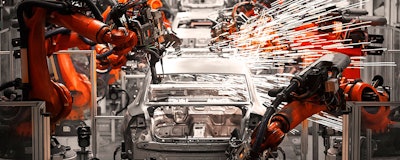
 Linda Caron, Global Product Manager for Parker Hannifin Corporation
Linda Caron, Global Product Manager for Parker Hannifin CorporationWith the ever-increasing complexity of modern pneumatic components, it becomes crucial to know what to look for and what is best suited to your system. Choosing and maintaining system components wisely, right through from compressors to workstations, can help save the expense of unplanned downtime or costly rebuilds. Conversely, a few wrong choices can lead to everything from wasted energy to system failures. To avoid these pitfalls, here are some simple steps to take when looking to maximize the performance of your company’s all-important pneumatic components.
Preventive and Predictive Maintenance
Just like carrying out maintenance tests and oil changes on a vehicle, pneumatic systems also require regular upkeep to prevent more serious issues down the line. In compressed air systems, it is important to ensure that lubricators are not left to run dry; filters are cleaned; and all contaminants such as rust, metal shavings, water, and unwanted oils are removed.
Predictive maintenance is about being proactive, rather than reactive, to avoid component failures, and it is often the work of sensors (available for almost every factory component) that alert you to potential problems. A flow sensor that fits in-line with a Filter Regulator Lubricator (FRL) unit are able to identify blocked filters, while continuous position sensors can be an indicator over time to the wear to which cylinders are exposed.
Compliance and Safety
Making sure that a system is compliant with current standards is also critical to avoid costly downtime and equipment overhaul. The recently-updated standard known as DIN ISO 8573-1 governs filtration levels. Defined down to the micrometer, it identifies the solids, water and oil that should be separated out to maintain a well-functioning system.
Similar to checking system compliance, carrying out a risk assessment and consulting an administrative body that serves those involved in workplace health and safety are important procedures to help minimize the risk of workplace injuries. Bringing in light curtains, interlocks, machine guarding or safety exhaust products to block or prevent hazards can be impactful measures in this regard.
Specification and Integration
Right from the start of the specification process, selection of accurately sized equipment saves money and valuable energy, which oversizing wastes. As alternatives to oversizing and waste, consider implementing pressure boosters that allow the flow from a compressor to the largest workpiece, and pneumatic zoning on manifolds that can be used to mix pressures. The simple step of locking regulators prevents workers from adjusting a system’s overall pressure to supply more air to individual workstations which ultimately could damage a sealing system, waste energy, or even cause physical harm.
Updates in terms of the connectivity of the factory floor are worth considering as well. Low-cost Ethernet connections are more frequently replacing hardwired solutions and associated trunks of cables to provide network-based connectivity across a facility. IO-Link connectivity, to run field-level devices back to the IO-Link master, provides further opportunity for savings in time, wiring, component cost and troubleshooting. Additionally, many of today’s advanced network nodes are able to supply prognostic data for predictive maintenance and in-built sensors to check for shorts, over current, cycle counting, thermal management, among other things.
Linda Caron is a Global Product Manager for Parker Hannifin Corporation in Factory Automation, Pneumatic Division, Motion Systems Group in Richland Michigan. Linda is a CMSE, Certified Machinery Safety Expert (TÜV Nord) and has held various technical product management roles over 27 years in both Fluid Power (with various divisions of Parker and Festo) and the within the Electrical industry, serving global markets from Oil & Gas to the Food and beverage industry.






















